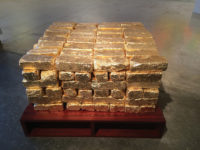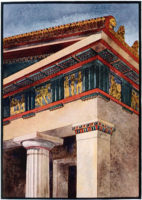While the formulation of high-performance paint is a technical process, the craft of forecasting that paint's color is an unscientific one, say color experts. Color forecasters hope to give both consumers and professionals some direction in the seemingly endless choices they have when selecting interior paints and finishes.
To develop their annual lists, forecasting teams research trends they see across multiple industries throughout the year and then search for repeating themes that will be translated into palettes. 'Trends continue to morph and evolve throughout the year,' says Donna Schroeder, manager of color and design for Pratt & Lambert Paints. 'Forecasting is an ongoing process that never really ends.'
Depending on the company, forecasts are introduced at strategic times of the year, and sometimes up to 18 months in advance. Sherwin-Williams introduces its annual forecast at the NeoCon trade show in June. 'We don't like to put our forecast out too far in advance,' says Jackie Jordan, director of color marketing for the company. 'We believe things change so quickly that if we forecast 18 months ahead, it might not be as relevant six or eight months down the road.'
Color forecasters agree that almost anything can serve as inspiration, from politics and the economy to pop culture, the automotive industry, and the arts. According to Erika Woelfel, director of color at Behr Paints, 'Even people talking about the decline of bees can influence the inclusion of honey-golden tones.' Jordan says the Sherwin-Williams forecast was inspired by a range of sources, from the '60s style of pop icon Adele to the steampunk aesthetic to bright neon and electroluminescent lighting. Fashion, of course, remains a major influence on interiors. 'If a color remains popular in fashion for at least two seasons, you see it filtering down into objects for the home,' says Woelfel. The research needs to remain hands-on to be useful, however. 'At the end of the day, we are a paint product, and we have to work with actual samples and actual products,' she says.
Even though forecasts for the same year may vary from company to company, the process is far from subjective, says Benjamin Moore senior interior designer Sonu Mathew. 'It's an observation of what's happening in the world,' she says. It also extends beyond the consumer audience. Dee Schlotter, brand manager of PPG Pittsburgh Paints' program The Voice of Color, says 70 percent of PPG's business is professional, with much of that commercial. 'Providing the trends and forecasting service for them is extremely helpful in their new projects,' says Schlotter, adding that the company sees the most interest in its trends program in the hospitality, retail, and health-care sectors.
Pantone, known as the definitive color authority, issues several color forecasts a year. 'All manufacturers and designers today are very aware of how important forecasting is and try to stay abreast by looking ahead,' says Leatrice Eiseman, executive director of the Pantone Color Institute. This does not, however, 'preclude them from using their knowledge and instincts,' says Eiseman, 'but can validate a direction or give new inspiration and direction.'
So what's the hot color for 2013? It depends which forecast you check. But whether it's Lemon Sorbet, Awesome Violet, or Monaco Blue, one thing is for sure'the forecasters are already hard at work looking for what's next.









Post a comment to this article
Report Abusive Comment